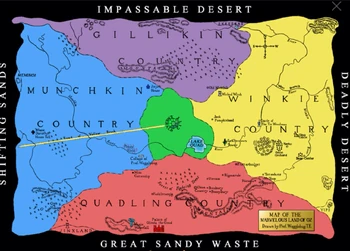
Gillikin Country is the northern quadrant in the Land of Oz, home to the Gillikins.
Background
Gillikin Country is the only region in Oz that is not mentioned by name in the first book, The Wonderful Wizard of Oz. L. Frank Baum first used the name "Gillikin" at the beginning of the second book, The Marvelous Land of Oz. In her books, Ruth Plumly Thompson generally spells the country's name "Gilliken."
The dominant color of Gillikin Country is purple, and its people are occasionally described as wearing purple clothes and even sometimes having purple hair. Of the four quadrants of Oz, Gillikin is known as the wildest and least explored, home to vast forests and mountains.
Etymology
Martin Gardner suggests the name Gillikin may be named after the purple blossoms of the gillyflower.[1] Baum used the name "Gilligren" for the protagonist of his story "Sing a Song o' Sixpence" in Mother Goose in Prose.
Known Locations and Residents
Like all of the countries of Oz, the Gillikin Country contains various unusual sights and places. Among them are:
- The forest of the Winged Monkeys, creatures that obey whoever wears the enchanted Golden Cap
- The palace of the Good Witch of the North
- The house and farm of Mombi, the former Wicked Witch of the North and former ruler of Gillikin Country, who kidnapped Ozma's grandfather. The Wizard paid Mombi to keep Ozma and her father prisoner while he ruled the land of Oz.
- The village of Loonville, whose balloon-like inhabitants warn strangers to stay away from their clearing (the Loons can also become too puffed-up)
- The Rolling Lands, an area of vast hills and valleys
- Candy County
- Dinker's Shop of Smokables
- Dragons living beneath the earth's surface, allowed to come out once every 100 years in search of food
- Flatheads, people living on a mountaintop whose heads are flat and carried their brains in a can in their pockets
- The Forest of Gugu
- The Hidden Valley and Terp the Terrible's Castle
- Kapurta, a kingdom which for part of its history was a floating island
- The village of the Lanternesians
- An unidentified jungle where the Leopard with the Changeable Spots lives
- The Magic Isle and nearby diamond palace of the Lonesome Duck
- Mist Maidens, fairies who live in a fog bank
- Pumperdink, an elaborate fairy tale kingdom that is known for dipping it's criminals in ink.
- Purplefield
- Reera the Red, a witch preferring her privacy who specializes in transformations
- Regalia, the sister city of Pumperdink.
- Skeezers, once friends and now rivals of the Flatheads who live within a glass city in the middle of a lake
- Giant purple spiders that catch travelers in their webs and make them their servants
- Up Town, proclaimed the capital of the Gillikin Country after the Good Witch of the North abandoned her post. It is inhabited by the Uplanders.
- Upandup Mountain
- The castle of Mrs. Yoop
- Zamagoochie Country
- The Equinots
- The Hoopers
- The Scooters
Non-canon stories
Much of Roger S. Baum's Dorothy of Oz takes place in Gillikin Country, including visits to Candy County, the town of Purplefield, and the forest of the Talking Trees on the banks of the Munchkin River.
In Gregory Maguire's revisionist Oz novels Wicked: The Life and Times of the Wicked Witch of the West and Son of a Witch, the Gillikin country is portrayed as more prosperous and industrially developed than other regions of Oz, and home of Shiz University. There is a railway (Great Gillikin Railway) that connects most of the Gillikin towns and connects to the yellow brick road at the location of Shiz. Galinda hails from Gillikin, as do (according to some) the ruling Ozma family. Gillikinese people are distinguishable by their prominent foreheads and slightly gapped front teeth. They often have heads of curling blond hair, and are believed to be temperamental by non-Gillikinese.
References
- ↑ Michael Patrick Hearn, ed., The Annotated Wizard of Oz (1973), page 101.